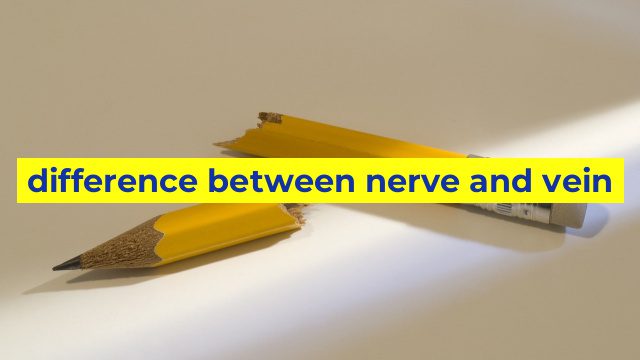The Difference Between Nerves and Veins
When speaking about the human body, we hear a lot about nerves and veins. They are both important components of our bodily functions, but they serve very different purposes. Here is a breakdown of the main differences between nerves and veins:
Nerves
Nerves transmit information in the form of electrical impulses throughout the body. Nerves are responsible for the communication between the brain and the rest of the body. They carry signals from the senses (such as touch, taste, and smell) and also control muscle movements. There are three types of nerves:
- Sensory nerves: These nerves carry signals from the senses to the brain.
- Motor nerves: These nerves carry signals from the brain to the muscles to control movement.
- Mixed nerves: These nerves have both sensory and motor functions.
Veins
Veins are blood vessels that carry blood back to the heart. They have one-way valves that prevent blood from flowing backward. Unlike arteries, veins are thin-walled and have less pressure, as they do not need to pump blood to the body. They play an important role in the circulation of blood and help regulate body temperature. There are three types of veins:
- Superficial veins: These veins are near the surface of the skin and are visible. They are the ones that cause varicose veins.
- Deep veins: These veins are found deep in the body and are responsible for the majority of blood flow. They are also the veins that are most commonly affected by blood clots.
- Perforator veins: These veins connect the superficial and deep veins.
The Main Differences
The main difference between nerves and veins is their function. Nerves are responsible for transmitting signals throughout the body, while veins are responsible for carrying blood back to the heart. They also differ in their structure, as nerves are made up of specialized cells known as neurons, while veins are composed of three layers of tissue. Another key difference is that nerves are not visible, while many veins are visible under the surface of the skin.
Conclusion
In summary, nerves and veins are both important components of our bodily functions, but they serve very different purposes. Understanding the differences between them can help us better appreciate how our bodies work and help us identify potential health problems that may arise. It’s essential to take care of both our nerves and veins to maintain our overall health and well-being.
Table difference between nerve and vein
| Characteristic | Nerve | Vein |
|---|---|---|
| Function | Conducts electrical signals from the brain or spinal cord to other parts of the body; receives sensory information and relays it to the brain or spinal cord. | Transports blood, carbon dioxide, and waste products from the body’s tissues back to the heart. |
| Composition | Consists of bundles of nerve fibers wrapped in connective tissue. | Consists of thin-walled, flexible tubes with valves that prevent backflow of blood; lined with endothelial cells and surrounded by smooth muscle and connective tissue. |
| Color | White or grayish-white | Dark red or blue |
| Shape | Usually long and thin, with a cylindrical or flattened shape. | Irregularly shaped and often branched or twisted. |
| Response to Injury | Can regenerate if injured, although the process may be slow and incomplete. | May form blood clots or scar tissue to repair injury; may also become swollen or hardened in response to injury. |

